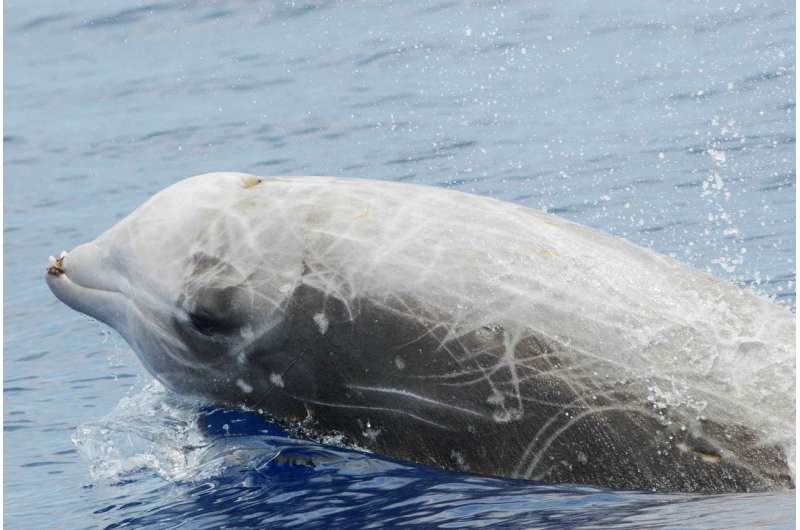Two beaked whale species take very long, deep dives for their size

Two relatively small beaked whale species took exceptionally long, deep dives while foraging in the Bahamas, confounding expectations that larger whales dive should be able to dive for longer than smaller whales, according to a study published October 11, 2017 in the open-access journal PLOS ONE by Trevor Joyce from Scripps Institution of Oceanography, United States of America, and colleagues.
Most species of Ondotocetes (toothed whales and dolphins) eat creatures found at depths from tens to thousands of meters, and beaked whales dive as deep as 2,992 meters for their prey. Dive capacity in Ondontocetes generally increases with body mass, presumably because bigger bodies have more substantial oxygen reservoirs. However, another hypothesis holds that beaked whales—a type of toothed whale—extend the duration of deep dives by shifting from aerobic to anaerobic respiration.
To examine these competing hypotheses, Joyce and colleagues used satellite telemetry and biologging to study dive patterns of five toothed whale species foraging in underwater canyons in the Bahamas. The researchers tagged 17 beaked whales (12 Mesoplodon densirostris and 5 Ziphius cavirostris) as well as 13 melon-headed whales (Peponocephala electra), 15 short-finned pilot whales (Globicephala macrorhynchus), and 27 sperm whales (Physeter macrocephalus). Data included body weights, concentrations of myoglobin (a muscle protein that binds oxygen), and intervals between deep dives.
The researchers found that the two beaked whale species took very long, deep dives for their size. They also took exceptionally long recovery periods between deep dives. These inter-deep-dive intervals averaged 62 minutes for M. densirostris and 68 minutes for Z. cavirostris.
When taken together, body size and myoglobin concentration explained only 36% of the variance in maximum dive times. However, when inter-deep-dive intervals are also considered 92% of the variance in maximum dive times is explained. Longer inter-deep-dive intervals likely correspond with metabolism of the lactic acid that accumulates during anaerobic respiration, supporting the hypothesis that beaked whales extend their foraging dives by shifting from aerobic to anaerobic respiration.
The researchers suggest that this alternative strategy allows the beaked whales to access deeper prey without growing larger, which fits with the fact that prey is limited at the extreme depths, of up to 1,900 meters, where they forage.
More information: Joyce TW, Durban JW, Claridge DE, Dunn CA, Fearnbach H, Parsons KM, et al. (2017) Physiological, morphological, and ecological tradeoffs influence vertical habitat use of deep-diving toothed-whales in the Bahamas. PLoS ONE 12(10): e0185113 doi.org/10.1371/journal.pone.0185113
Journal information: PLoS ONE
Provided by Public Library of Science



















